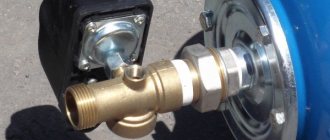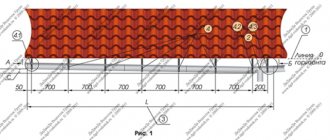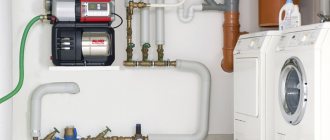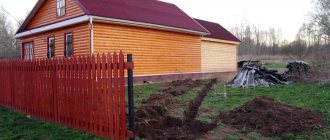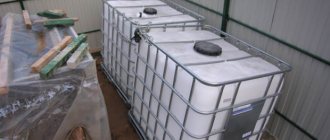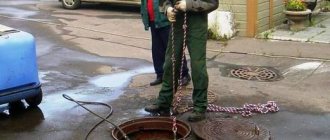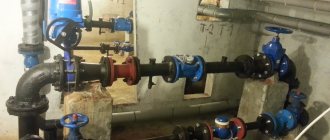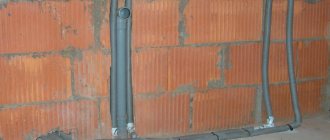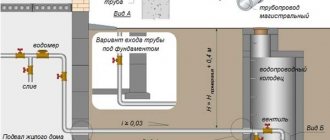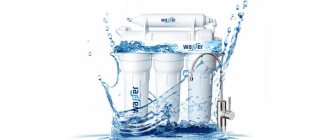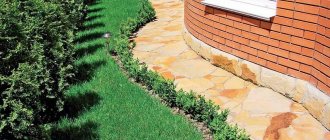Residents of high-rise buildings have more than once encountered a situation where a feeble trickle of water flows from an open water tap.
This happens due to lack of pressure in the pipeline.
What water pressure should be in the water supply of an apartment building so that, regardless of the number of open taps, the use of the benefits of civilization is comfortable for each of its inhabitants?
Water supply pressure standard
The household drinking water supply system (as builders call our water supply network that delivers water to the apartment) is designed based on the requirements of SNiP 2.04.02-84.
It says: different points in the network have their own standard pressure level assigned.
The pressure in the water supply of the upper floors depends on the level at which the pressure in the network is maintained at the entrance to the house.
This parameter depends on the number of floors. If the building is one-story, then at the inlet the water pressure in the network must be at least 10 m. Art. or 1.0197 atm. This means that the pressure in the pipe is enough to raise water to a height of 10 meters. In multi-storey buildings, another 4 m should be added to each subsequent floor. Art. For example, in a 5-story building, the water pressure at the entrance to the building should be 10 + 4x4 = 26 m in. Art. If the resulting figure is converted into atmospheres, the result will be as follows:
(26:10) x 1.0197 = 2.65 atm
However, the above figure is not a limit, but an estimate. According to the standards in force in Russia, the pressure at the entrance to the house is considered normal for a centralized water supply system to be 4 atm. (approximately 40 m in. Art.).
Insufficient pressure in the tap is a situation that many people have encountered. If this happens often, you need to correct the situation. A water pressure booster station is an indispensable assistant for your comfort.
You will find a guide to making a check valve with your own hands here.
A bailer is a simple and very useful device for cleaning a well. Here https://aquacomm.ru/cancliz/mnogokvartirnyie-doma/santehnika/obratnyj-klapan-svoimi-rukami.html you will find instructions for making it yourself, and also learn how to drill a well using this tool.
What is regulated
The pressure in the water supply system is regulated by the provisions of SNiP No. 2.042 of 1984, and the amended SNiP of 1985.
In accordance with this standard, the entire water distribution network of the building is designed, starting from the supply to the building and ending with water intake devices - mixing taps.
In an apartment building
The formula for calculating the required pressure in water supply pipes in a five-story building is as follows:
1bar + (0.4bar x 5 floors) = 3 bar.
Here 1 bar is the minimum pressure for the 1st floor, 0.4 bar x 5th floor. - an increase in the indicator per each of the subsequent floors of the house.
As a result, we get the minimum pressure that must be ensured at the entrance to a five-story building of 3 bar. Using the same formula, you can calculate what water pressure should be in the water supply of an apartment building if it has 9, 12...15 floors. To increase the pressure, you can install a booster pump.
In a private house
For a 1-story building, SNiP regulates the technical minimum of 1 atmosphere. This pressure allows shower and kitchen faucets, toilets and other standard plumbing equipment to function smoothly.
However, it should be taken into account that this standard was drawn up back in 1984, when residents did not yet have such a quantity of household appliances at their disposal. For their normal operation, a significantly higher water pressure will be required - at least 2 atm. This should also be taken into account when designing the water supply system of a private residential building.
Exact numbers according to regulatory documents
SNiP 2.04.02-84 stipulates the maximum permissible free water pressure at the entrance to the apartment: it should not be higher than 6 atm.
That is, if you live in a 22-story building, the pressure at the entrance to it will be at least 9.4 atm, but when the pipeline enters the apartment, this parameter should be reduced to 6 atm.
Moreover, there are standards for free water pressure for each type of plumbing fixture:
- 0.2 atm – for a washbasin with a mixer, a toilet with a flush cistern;
- 0.3 atm – for baths and showers with mixer.
The maximum hot water pressure in the area of plumbing fixtures should not exceed 4.5 atm.
The above values are valid not only for a centralized water supply network, but also for autonomous water supply.
At what values does the equipment function normally?
The minimum indicators for the operation of sanitary equipment are the following values:
- 0.2 atmospheres for a washbasin with mixer tap;
- 0.3 atmospheres for a bath with mixer;
- 0.3 atmospheres for a shower cabin;
- 0.2 atmospheres for a toilet with a flush cistern;
- 0.3 atmospheres for bidet;
- 4 atmospheres for normal operation of the jacuzzi and hydromassage equipment.
For the operation of household appliances, you must have the following values:
- 2 atmospheres for washing machine;
- 1.5 atmospheres for dishwasher;
- from 1.5 to 2.5 atmospheres for the operation of the heating boiler, depending on the parameters of the heating system.
To organize an irrigation system in a private house, the water pressure must be 3.5 atmospheres.
For complete consumption
For full consumption, when you can turn on all devices that use water, the minimum pressure in the pipes should be 2 atmospheres. A level of 4 atmospheric units is considered normal.
Danger of overfeeding
If the water pressure supplied to residential premises is too high, breakdowns of household and sanitary appliances, ruptures of water pipes and other troubles can occur.
For example, the maximum water pressure for sanitary fixtures is 4.5 atmospheric units; if it is exceeded, plumbing equipment may fail . To reduce water pressure, special devices are used, for example, a pressure reducer .
What pressure is enough for full consumption?
Most apartment building residents use water in a very predictable manner. They shower periodically, wash dishes daily, wash their face, and turn on the washing machine several times a week. To ensure these manipulations, it is enough to have a pressure (pressure) of 2 atm in the water supply. If a massage shower or jacuzzi is installed in the bathroom, they will only work at a pressure of at least 4 atm.
Excessively high pressure in the network leads to rapid wear or irreversible destruction of ceramic faucets and sanitary equipment.
Some features of autonomous water supply systems
The source of autonomous water supply is a well or borehole.
In both cases, water is supplied to the pipeline through pumps. It is this unit that creates the pressure in the pipes necessary to deliver water to consumers - taps, washing machines or dishwashers, etc.
However, not only its power and performance affect the level of free pressure in the water supply. Well flow plays a big role in this issue.
If there is not enough water in the source, the pump will not be able to provide the required pressure in the network immediately after it is turned on. If there is an excess amount of water in the well, there is a risk of a significant increase in pressure, which can lead to various types of accidents - leaks, broken faucets, etc.
In the first case, the homeowner has to take measures to increase the water pressure in the water supply; in the second, he must correctly select the pump capacity so that it plays the role of a kind of limiter.
Consequences of pressure deviations from the norm
One of the important technical characteristics that determine the normal functioning of the water supply system is water pressure. Non-compliance with its established values in either direction can cause a number of problems.
High blood pressure poses a threat:
- violation of the integrity of threaded connections, couplings, fittings;
- damage to ceramic valves;
- failure of valves and other equipment of household appliances connected to the water supply.
Insufficient water pressure can cause not only everyday inconveniences that arise, for example, when washing dishes, taking a shower, but also a complete failure of operation - in the worst case, some sanitary appliances, geysers and instantaneous water heaters.
The compliance of water pressure in the pipelines of an apartment building with established regulatory values and standards must be monitored by the management company or the provider of this service. If necessary, adjustment work is carried out on the system
Any deviation of water pressure from the normatively prescribed one requires determining the cause of this malfunction and urgently taking measures to normalize the pressure.
How to increase water pressure in a water supply
A decrease in pressure in the pipeline can occur for several reasons:
- Gusts on a city highway. Utility networks in most cities are very old, so water leaks on the way to the consumer are not uncommon. The owner of the apartment is unable to eliminate this reason, so he can only rely on the city authorities.
- “Overgrown” pipes of the internal water supply system. In old houses, a huge amount of sediment is deposited on the inner surface of the pipes, as a result of which their throughput is significantly reduced. It’s easy to fix this problem: you just need to replace the risers and wiring inside the apartment.
What should be done if the plumbing system is not able to provide a normal level of free pressure? In this case, there is only one way out - to install pumping equipment in the apartment.
Water pressure booster pump
The pumping station used by private home owners is unlikely to be suitable here:
- Firstly, it is not allowed to install such equipment on a centralized water supply without special approvals. And the neighbors are unlikely to agree to this - they will definitely be left completely without water.
- Secondly, pumping stations are large-sized equipment, and installing them in an apartment is very problematic. And if we add the harness to this, it becomes clear that such a unit is not suitable for the average apartment.
But not everything is so gloomy - manufacturers of pumping equipment produce booster pumps designed specifically for “apartment” installations.
Where to contact if you do not meet the requirements?
If the cause is not the devices and pipeline inside the apartment itself, then you should file a claim with the Criminal Code .
You need to file a complaint. This document requires you to write that the company provides services of poor quality.
It is also necessary to require the management company to check the condition of the water supply system in the house and at the pumping station, as well as recalculate the completed and sent utility bills.
The management company must respond to the complaint within 30 days . If the company does not take proper measures, then you should contact the housing inspector. You can also complain about the inaction of the Criminal Code to the city administration and the prosecutor's office. If these structures do not take proper actions, then a lawsuit should be filed.
Pump classification
Pumps that increase water pressure in a water supply system, intended for use in an apartment, are a small device installed at the entrance of the pipeline to the apartment. Almost all pumps can operate in two modes:
- manual;
- automatic
Automated pumps to increase pressure turn on independently when you open any of the existing taps in the apartment. The flow sensor provides this function. It is triggered by the movement of water in the water supply. Pumps equipped with such sensors are protected from burnout during dry operation.
Automated Boost Pump
Boost pumps according to the principle of operation of the cooling system are classified as follows:
- With a dry rotor: an impeller is mounted on the rotor, which forces air onto the motor housing. The efficiency of such models is high, but their operation is accompanied by noise.
- With a wet rotor: water passes through the pump, cooling the motor. The main advantage of such pumps is their silent operation.
Some models of booster centrifugal pumps are designed for hot or cold water only.
Features of water supply in an apartment building
Centralized water supply schemes in urban areas consist of several technological cycles:
- Water intake. For drinking water, it can be constructed from a fairly deep river or a system of artesian wells.
- A water treatment station where filtration and sedimentation of solid fractions are carried out, as well as water disinfection from bacterial components and chemically harmful substances. At the exit, the liquid must undergo quality control in a special laboratory.
- Water prepared for use is accumulated and stored in special large tanks.
- Prepared water is taken from the storage tanks by a water pumping station and distributed further.
- The water supply network is connected to the house distribution networks and is supplied through risers to the apartment distribution networks.
Indoor water supply networks can have various configurations. Let's look at them for a clear understanding of the issue.
Tee wiring in the apartment
This method of forming a water supply system in apartments is still used today.
It includes the following main elements:
- Distribution pipe connected to the riser. In this case, a mandatory element of the design is a ball valve at the inlet.
The use of a coarse filter is mandatory. It deposits contaminants present in the water on its mesh. Without it, pipes quickly become clogged and impede flow, often causing a drop in pressure.
The filter needs regular cleaning. The frequency of its implementation depends on the degree of contamination, which is determined independently during operation.
- During the installation of the water supply system, tees are cut into the distribution pipe, from which various plumbing fixtures and household appliances are connected.
- Flexible hoses are used to connect bathtubs, showers and other water points.
- When connecting many types of household appliances, manufacturers recommend installing an additional fine water filter in the water supply.
The advantage of this layout of the plumbing system is the minimal need for pipes and fittings.
But the disadvantages are also quite significant:
- when repairing and servicing the wiring, it is necessary to turn off the water at the central tap, as a result of which the use of other water intake points is impossible;
- When several taps are opened at the same time, the pressure in the water supply network drops sharply, making it difficult to use water.
Collector wiring in the apartment
The wiring diagram using a collector looks somewhat different. In this case, the same supply pipe is connected to the riser, but it does not participate in the distribution of water flows, but ends with a collector.
It is a body from which branch taps are installed to various points of consumption, including plumbing equipment and household appliances.
With this construction of water supply distribution, the pressure in different branches of the network will be the same.
In addition, the comb has the ability to shut off individual branches for repair or maintenance. At the same time, the rest are working as normal.
The routing of pipes according to the collector circuit allows you to adjust the water supply mode individually for each point of consumption, depending on its characteristics. In this case, it is advisable to use a pressure switch. If a particular device has increased requirements for water quality, additional filters can be installed in front of the desired device.
The disadvantages of the collector circuit include the need for a relatively larger number of pipes. But this is compensated by the reliability and ease of use of the pipeline.
Mixed schemes
They are used when it is necessary to install a complexly branched pipeline over a long distance. To avoid pulling pipes over a significant distance.
To do this, a second supply pipe is installed through a tee at the inlet and another comb is connected to it to organize the wiring.
Such complex systems can be used in large country houses and cottages.
Pump for water pressure in water supply
The most popular brands of pumps among apartment owners are:
- Comfort: efficient and economical devices. Pumps of this brand are classified as universal - they can be installed on hot and cold water. The product body is made of stainless steel. There are seven modifications, differing from each other in the design pressure (from 8 to 10 m) and throughput (nominal - from 8 to 12 l/min, maximum - from 20 to 30 l/min);
- WILO: domestic pumps of European class, excellent quality, universal. Vilo pumps are equipped with a flow sensor, the motor cooling system is “wet rotor”. They are designed for maximum pressure from 9 to 20 m and flow capacity from 2.4 to 35 l/min (depending on the model);
The UNIPUMP pump also received good reviews. It has a small installation length, which makes it easy to install.
Ways to increase pressure in the system
The problem with water pressure, especially in old houses, may be of a structural and technical nature, over which utility workers are powerless. Also, to save energy resources, suppliers often turn off one or more general house booster pumps. Due to redundant circuits, the water supply does not stop completely, but the pressure in the system is significantly reduced.
In such a situation, it becomes necessary to use one of two or two simultaneous methods of equipping the water supply network with additional equipment to increase the pressure and pressure of water.
Method #1 - flow pump
Pumps of this type increase water pressure without additional intake, and no permits are required for their installation in apartments.
There are several types of these devices, differing in characteristics such as:
- type of control (manual, automatic);
- permitted water temperature;
- cooling method.
The built-in sensor of the device automatically reacts to a drop in pressure in the system and raises it to the optimal value.
Structurally, a flow pump consists of a wet rotor, which is located in the pumped water. The rotor is separated from the starter by a thin stainless steel sleeve
Units of this type are classified as surface circulation pumps. They are easily and quickly installed on existing utility networks. As a rule, additional reconstruction of the system to install flow pumps is not required.
The pressure pumped by the pump can be adjusted either manually or automatically.
When selecting a pump, it is necessary to compare its performance with the water consumption in the apartment, so that when several household appliances that consume water are used simultaneously, the throughput of the unit is sufficient for their normal operation.
For example, a pump with a capacity of 3.5 m3/hour will be sufficient for three water collection points.
Flow-through circulation pumps, small in size and weight, can be installed at the entrance of the central main line to the apartment, as well as directly in front of the water-consuming plumbing household appliance or geyser.
Among the most popular models of units for this purpose, we can highlight the device from the Belgian manufacturer Grundfos UPA 15-90, which has great market demand and a decent price-quality ratio.
The pump has a very good noise characteristic - 35 dB, which does not require additional sound insulation in residential areas. Despite the low power consumption - 120 W, the water pressure in the system increases by 0.6 - 0.8 bar.
An important specification of the unit is automatic blocking when water flow is less than 90 liters per minute and wet rotor protection (simultaneous cooling and lubrication).
The pump can be installed in both vertical and horizontal positions.
Method #2 - pumping station
If there is no effect from using a flow pump, a more radical measure would be to install a pumping station in the apartment to increase the pressure.
Often only such a forced measure can solve problems with water pressure for residents of the upper floors of high-rise buildings.
Structurally, the storage station consists of a pump and a water accumulator - a membrane tank. The pump pumps water into the tank and then delivers it to the water points
Using a pressure switch, water is supplied to the consumer with the required, predetermined pressure. When the receiver is full, the pump turns off.
The operation of the station is resumed after the water in the accumulator has been used up.
The advantages of such a device:
- the ability to use water even if it is not available in the water supply system;
- resistance to changes in water pressure.
But it should be borne in mind that such units have relatively large dimensions and are noisier than flow pumps. This imposes certain inconveniences in using them in apartments.
In addition, a powerful pumping station can suck air from apartments located on the same water supply risers, which will lead to the pump turning off and the need to fill the system with water.
Pumping stations are more widely used in private houses on autonomous water supply systems.
We provided recommendations for choosing a pumping station for increasing pressure and an overview of the top ten proposals in the following article.
How to reduce water pressure in a water supply
Too high pressure in the pipeline can lead to pipe destruction and failure of household appliances.
Everyone knows the terrible word “water hammer”, as a result of which faucets begin to drip, fistulas appear on the pipe, etc.
You can protect your apartment water supply network from such troubles with the help of a small device - a water pressure reducer.
Household appliances are set to an inlet pressure of no more than 60 bar. At the outlet, the reducer can maintain pressure from 0.5 to 6 bar.
The water pressure regulator in the water supply can be installed at the entrance of the water supply to the apartment or in front of household appliances - a boiler, washing machine and other devices that do not tolerate high pressure.
How to understand who is to blame for poor pressure?
The following reasons for insufficient pressure in the water supply system are possible:
- clogs inside faucets, as well as in water filters;
- failure of mixers;
- fouling of pipes from the inside with plaque;
- breakdown of the filter element inside the geyser, if it is used in an apartment.
In these cases, the tenant himself is responsible for poor pressure in the pipeline, since the decrease in pressure was caused by a breakdown or clogging of devices that are located within his own apartment.
This property will be considered personal. The resident will have to clean the filters and faucets themselves or replace them completely.
He will also have to replace individual pipeline sections in the apartment with his own resources and resources if they are severely damaged by lime. Also, if the filter element in a gas water heater breaks down, the resident will have to repair the device using his own means.
It is recommended to first check all faucets with filters in your home . If necessary, you can gently tap the pipes with a hammer to get rid of excess lime inside them. Also, if you have a geyser, it is recommended to check the filter element inside it.
If the cause is not faucets with filters, as well as the pipeline inside the apartment, then it is necessary to check the connections of the pipes in the entire water supply system.
It is recommended to check the condition of the riser and all equipment installed in the basement of the house. To do this, you will need to contact the Criminal Code. The pumping station may also need to be checked.
How to find out pressure
Accurate information about the pressure in the pipeline is required when developing a system for its normalization. To do this, install a water pressure gauge to measure the water pressure in the water supply and take readings from it within a week.
This is done at least 4 times a day: at night and in the morning, during the day and in the evening. Based on the results obtained, maximum and minimum values are determined and compared with regulatory requirements. Based on the result obtained, the optimal method of increasing pressure is selected.
You have probably encountered such a problem as noise in water pipes. Many people try not to pay attention to this, but in fact this problem needs to be solved. Why water pipes hum and how to diagnose and fix the problem, read on.
We will discuss ways to replace the gasket in a faucet in this topic.
How to increase blood pressure
If all measures to stabilize constant low pressure, such as contacting the housing office or replacing intra-apartment wiring and filters, do not produce results, you can resort to installing special equipment. There are two ways to increase pressure:
- Connecting a circulation pump that increases the pressure by drawing in water. This is an excellent solution for an apartment: the device is small in size and can be installed in the water supply in front of water access points.
- Installation of a pumping station. Despite the advantage of such equipment in terms of power, this option has serious disadvantages: the station requires special approval and takes up a lot of space.
Minimum and maximum pressure pressure in the cold water pipeline according to GOST
Standards for acceptable (minimum and maximum) values are specified in regulatory documentation affecting water supply networks. Including the building codes and regulations (SNiP) established by law.
Units
To understand the data presented in the documents that determine the number of atmospheres required for a stable supply of liquid, you need to understand how the specified quantities (v and p) are interrelated.
Omitting unnecessary terminology, it should be said that pressure is a kind of force that acts on any obstacles in the path of water flow. That is, we can safely say that it is endowed with potential energy. When the water does not move, its complete absence is observed. But the pressure, being a linear unit, in such a situation reaches its maximum value. In established standards and regulations, the pressure parameter means the smallest height to which the liquid must be raised so that it can overcome the resistance of the pipeline and reach the water intake zone.
The basic unit for defining p is Pascal. Direct water measurement is carried out in megapascals (MPa). There are also bars, atmospheres, kgf/cm².
Standards
The regulatory documentation spells out the main indicators in great detail. Compliance with them is necessary for the proper operation of water supply systems. So, for a residential 8-story building, the pressure indicator is calculated as:
10m+(4m*7 floors)=38m or 3.8 atm (kg/cm²).
By studying the documents, you can find out what water pressure and pressure in the tap in the water supply of a house is normal. For cold feed it is 0.3-6 atm, for hot feed - from 0.3 to 4.5.
The requirements for plumbing fixtures also differ. Lowest value in atmospheres at:
- shower cabin - 0.3;
- bath - 0.3;
- washbasin - 0.2.
Therefore, when planning the purchase of plumbing fixtures, it is necessary to take into account the above parameters. After all, each product is designed for a strictly defined minimum and maximum. If the instruction manual contains data below the standard, it means that the devices are not suitable for installation in the system.
It is worth noting that the range between the permissible lower and upper values specified, according to SNiP standards, is quite large. However, in fact, the optimal value suitable for stable operation of water supply networks is 4 atm.
MBFT-75 Membrane for 75GPD
SF-mix Clack up to 0.8 m3/h
SF-mix Runxin up to 0.8 m3/h
How is it measured?
As a rule, a pressure gauge built into the home system is used for measurements. When this is not available, you can assemble the measuring device yourself. To do this, just arm yourself with a pressure gauge, thread extension, 1-2-inch adapter and special tape.
First of all, you need to connect all the elements in series, then check the reliability of the joining points. A homemade device must be solid, the parts must not move. Next, you need to unscrew the watering can from the hose in the bathroom and fix its end in the assembled device. Then you have to open the valve and switch the shower-bath mode several times to get rid of air pockets. Only after this can measurements be taken. When the liquid flows through the improvised meter at full speed, the necessary information will be displayed on it.
Pressure in public and private pipelines
According to GOST, the pressure in the water supply network should be 4 bar
Optimizing pressure in a city water supply is impossible; in addition, accurate information about the pressure force is not currently provided. If the line complies with the established GOST, the pressure will be 4 bar. However, this figure often drops to 2.5-2.7 bar. Therefore, water consumption can be minimal.
In a private (autonomous) water supply system, the water pressure is calculated individually. This depends on the type of plumbing fixtures chosen, as well as the resistance indicator when the resource passes through the pipes from the source. The selected pumping equipment plays a huge role. The optimal indicator in the private sector is a pressure of 1.5-2 bar. You can check this with a pressure gauge.
Where to address the problem of incorrect water pressure
If it is established that the problem of low pressure in the water supply system is located outside the residential premises, refer the issue to the management company or the HOA.
Write a complaint in which:
- indicate that the water supply service is of poor quality;
- demand a recalculation for the days of provision of services that do not comply with the requirements of SNiP;
- demand that the discrepancy be eliminated and quality provision of public services be established.
The application must be reviewed within 30 calendar days.
If the requirements specified in the application are not met, the owner has the right to notify the supervisory authority. In most cases, it is better to report this to the local administration department for housing and communal services.
Ways to increase
You can increase the pressure in an autonomous water supply by technical means: using a storage tank or pumping equipment. These methods have their advantages and disadvantages.
Pump equipment
This method is suitable for apartments with a central water supply system and for country cottages and summer cottages with an autonomous water supply. Additional pumping equipment is used only if the main device does not meet the necessary requirements.
This is possible if the well is located far away or the power of the device for supplying water to the second floor is insufficient. An additional pump is installed at the entrance to the home wiring.
What water pressure indicators are considered normal?
The law does not establish specific values for water pressure. The state standard contains information that the value of the indicator for MKD should not be more than four atmospheres.
For some users it is lower than for others. The final figure is influenced by many factors: area, floor, etc. The permissible value varies between 2-7 atmospheres. During pressure testing, the pressure is increased to 10.
The issue of units of measurement and instruments for recording indicators requires separate consideration. Modern household appliances are quite sensitive to water pressure. If it does not correspond to the permissible value specified in the instructions, this will lead to a breakdown or error when turned on.
Be careful, since the permissible pressure in the water supply is indicated in different units:
- atmospheres;
- bars;
- meters of water column.
Most often in everyday life the first of them is used.
Conversion of values from one measure to another is carried out as follows: 1 bar = 1.0197 atmospheres = 10.19 meters of water column.
Deviations
Now let's look at the problems and their solutions.
Centralized water supply
- Who is to blame, and what to do if there is no pressure in the city water supply system?
This problem may be caused by:
- Insufficient productivity or insufficient pressure at the output of pumping stations installed without taking into account further development of the microdistrict;
The pumping station must cope with peaks in water consumption
- Malfunction of pumping stations;
Let us clarify: pressure booster pumps must be backed up in case one of them fails. However, installing a backup pump is only possible with sufficient funding, which often poses problems when there are large arrears for rent and utility bills.
- Overgrowing of steel and (to a lesser extent) cast iron main water pipelines with deposits and/or rust.
Over time, deposits reduce the clearance of steel pipes
None of these problems can be fixed by the homeowner himself. A simple instruction will help speed up the work of specialized organizations: every time you don’t have water during peak water consumption (usually in the morning and evening), call the emergency service and draw up a report indicating the current pressure in the cold water system at home.
- How to measure the current pressure on the cold water supply?
The water pressure gauge in the water supply system is usually located in the water meter unit.
Water meter with pressure gauge after the meter
If it is necessary to take measurements on the riser, a laboratory pressure gauge is screwed in instead of a plug or into the thread of the sump.
- What can you do yourself if there is no pressure in the water supply system of an apartment building?
Check that the valves on your cold water supply lines and riser are fully open. Visit the water meter and make sure that the valves or ball valves are not covered. If you have coarse filters on your liners, open them and wash the mesh.
A clogged filter can limit the flow of your water supply
Often the cause of a drop in pressure on the riser or supply line of the cold water supply system is debris accumulated in a narrow place in the water supply system - under the seat of the screw valve. To clean it, just unscrew the valve head (of course, after turning off the water) and remove scale, rust and sand with a screwdriver or any other suitable object.
Bottlenecks in an overgrown riser or bottling can be indicated by the characteristic hissing of water when drawing water. By cooperating with your neighbors, you can replace the riser from the bottling to the top floor, without waiting for the house to undergo major repairs.
Complete or partial replacement of risers will solve the problem of low pressure due to deposits in steel pipes
- How to reduce pressure in taps?
And in this case, it all depends on what kind of problem you want to solve:
- If you are concerned that water consumption increases as the pressure increases, teach family members not to open the taps completely or, if this is problematic, install needle throttles on the connections to each mixer to forcefully limit the flow rate;
1/2" Needle Throttle Valve
- If you are afraid that the water supply system itself may be damaged by high pressure, a pressure reduction will be provided by a reducer installed at the inlet;
Reducer at the water supply inlet
- If increased pressure is dangerous for individual plumbing fixtures, filters or household appliances, the same reducers are installed on their connections.
Piston gear design
Autonomous water supply
- How to ensure increased pressure in the water supply system of a private home?
It all depends on the symptoms of the problem you have:
- If you observe short-term drops in pressure during active water withdrawal through several taps, a capacious hydraulic accumulator connected to any point in the water supply will save the situation. Within the limits of its effective capacity, it compensates for the excess flow over the water flow rate. Do not forget to install a check valve at the water supply inlet, which will prevent water from the membrane tank from draining back into the water supply main;
In the photo - a hydraulic accumulator in the water supply system
- How to increase stable low pressure? This can only be achieved by installing a water storage tank and a pumping station. A container installed in a basement or other room with a year-round positive temperature creates a supply of water during peak consumption; a pumping station with a hydraulic accumulator provides acceptable pressure in the water supply.
How to create additional pressure? Supplying water with a pump from a storage tank
- How to reduce the pressure drop in the water supply system of a private house between the moments when the pump is turned on and off?
By adjusting the pressure switch for the water supply system - by reducing the pressure at which the pump turns off, or by increasing the threshold for turning it on. In the second case, do not forget to raise the pumping pressure of the hydraulic accumulator to the appropriate value. Please note that this will cause the pump to start more often, which will significantly reduce its service life.
Reliable and silent pressure switches for DAB water supply systems allow you to adjust the pump on and off pressure in the range of 10-90 meters
Causes of low pressure in pipes
A number of cases have been recorded that may cause a decrease in water pressure in any type of pipeline.
- The presence of a large blockage in the cross-section of the pipeline, build-up of silt and other deposits. Over time, the lumen of the pipes decreases, and accordingly the pressure may drop.
- Accident at the pumping station. If the equipment is not working properly, some problems may arise with the rate of water supply to homes. This may be accompanied by a decrease in pressure or its complete absence for a long time.
- There is no electricity. The pumping station operates from the electrical network, so when it is turned off, there is a decrease in water supply to apartment buildings and private buildings.
- Leak formation. If there is a loss of resource in the main line leading to the house, this significantly affects the pressure. Under such circumstances, the pressure decreases and water may flow in a thin stream.
- Increased water intake. This problem occurs in late spring, summer and autumn. Most of the population gardens and prepares food for the winter. For many people, the fruits grow right on their home plot, even in multi-storey residential areas.
Residents can only endure interruptions in water supply. At best, you can write a collective letter to an organization that provides water supply services. A prerequisite for this is the requirement to regularly measure the water pressure in the pipeline.
